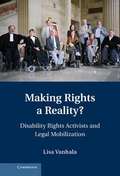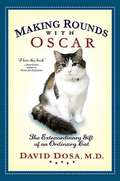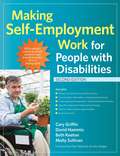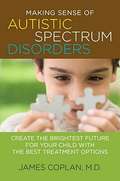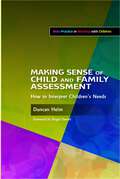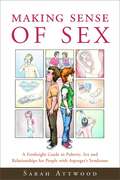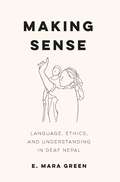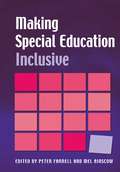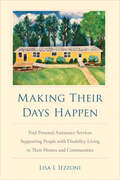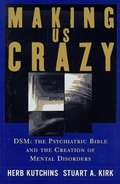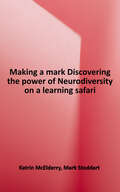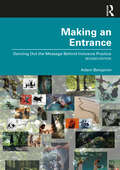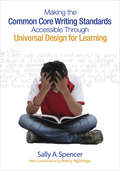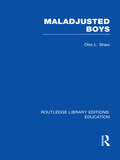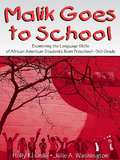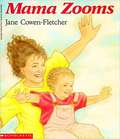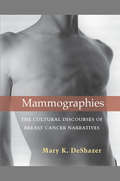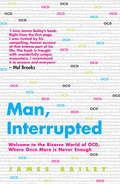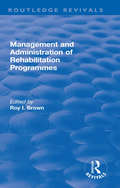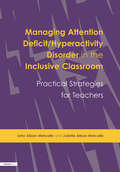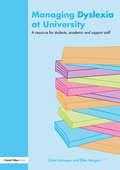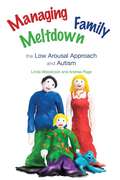- Table View
- List View
Making Rights a Reality? Disability Rights Activists and Legal Mobilization
by Lisa VanhalaMaking Rights a Reality? explores the way in which disability activists in the United Kingdom and Canada have transformed their aspirations into legal claims in their quest for equality. It unpacks shifting conceptualizations of the political identity of disability and the role of a rights discourse in these dynamics. In doing so, it delves into the diffusion of disability rights among grassroots organizations and the traditional disability charities. The book draws on a wealth of primary sources including court records and campaign documents and encompassing interviews with more than sixty activists and legal experts. While showing that the disability rights movement has had a significant impact on equality jurisprudence in two countries, the book also demonstrates that the act of mobilizing rights can have consequences, both intended and unintended, for social movements themselves.
Making Rounds with Oscar: The Extraordinary Gift of an Ordinary Cat
by David DosaAn otherwise ordinary cat, Oscar has the uncanny ability to predict when people in the Steere House nursing home are about to die. Dr. Dosa tells the stories of several patients and examines end-of-life care as it exists today. From text: Though my interviews with decedents' families were meant to provide me with more insight into what Oscar does, I found myself learning a great deal more about the diseases that had destroyed my patients' lives than I did about the cat. For all the mystery surrounding Oscar, there was little mystery about the devastating consequences of dementia.
Making Self-Employment Work for People with Disabilities (Second Edition)
by Cary Griffin David Hammis Beth Keeton Molly Sullivan<p>As self-employment becomes a viable option for more and more adults with significant disabilities, give them realistic, practical guidance and support with the NEW edition of this popular guidebook. Updated with a new and improved assessment approach, more self-employment success stories, and the latest on policy changes and online opportunities, this book is your step-by-step guide to helping adults with disabilities get a small business off to a strong start. You'll discover the nuts and bolts of person-centered business planning, and you'll get concrete, step-by-step strategies for every aspect, from business plans to marketing to finances. A must-have resource for employment specialists, transition professionals, and individuals with disabilities and their families, this book is the go-to guide for turning a small business into a big success. <p> <p>SUPPORT PEOPLE WITH DISABILITIES AS THEY: <p> <li>discover their "personal genius" with a new assessment approach <li>build a thorough and professional business plan based on their goals and interests <li>successfully finance their small business using multiple revenue sources <li>market their business, from defining customers to advertising in a variety of media <li>maintain their benefits while navigating financial and social security systems <li>make the most of valuable support from rehabilitation personnel, vocational counselors, school transition staff, and community programs</li> </p>
Making Sense of Autistic Spectrum Disorders: Create the Brightest Future for Your Child with the Best Treatment Options
by James Coplan M.D.In this authoritative and empowering book, one of the world&’s leading experts on early child development gives caregivers of children on the autistic spectrum the knowledge they need to navigate the complex maze of symptoms, diagnoses, tests, and treatment options that await them. For more than thirty years, James Coplan, M.D., has been helping families cope with the challenges posed by autistic spectrum disorders (ASD). Each family that walks into his office, he knows, is about to begin a journey. With this book, he lays out the steps of that journey. Dr. Coplan brings you into the treatment rooms and along for the tests and evaluations, and provides the kind of practical hands-on guidance that will help you help your child with ASD through every phase of life. At a time when ASD has become the subject of wild theories and uninformed speculation, Dr. Coplan grounds his recommendations in reality. He helps you understand for yourself where your child may be on the spectrum that includes autism, Asperger Syndrome, and Pervasive Developmental Disorder-Not Otherwise Specified. His clear, comprehensive, and compassionate advice prepares you to make informed medical decisions, evaluate the various educational and therapeutic alternatives, and find answers to such fundamental questions as • How do I optimize my child&’s long-term potential?• Which interventions will best serve my child?• How do the various therapies work, and what is the evidence to support them?• What is the best way to teach my child? This book empowers you to be an expert advocate for your child, so that you&’ll know when to say no to an ill-advised therapy or medication and can make with confidence the hundreds of important decisions you will face in the years ahead. For every parent who has made the painful transition from &“Why did this happen?&” to &“What can we do to help our child?,&” here is the indispensable guidebook you&’ve been waiting for.
Making Sense of Child and Family Assessment
by Duncan HelmThe application of assessment frameworks hinges on human qualities and skills which are naturally prone to bias and inconsistency. Making Sense of Child and Family Assessment aims to support workers in analysing and making sense of the information gathered, and increasing accuracy and empathy in assessing the needs and risks for vulnerable children and young people. This book offers best practice guidance on how to analyse information gathered during the assessment of children and young people and their families. Good assessments take time and need to be appropriately resourced. A range of analytical tools are also needed if practitioners are to present assessments of children's needs which lead to meaningful care plans and improved outcomes. Helm introduces the key messages emerging from policy and research, and provides insights into today's multi-disciplinary practice. Professionals working in child welfare and protection roles, such as social workers, health visitors, midwives and teachers will find this practical guide to analysis invaluable in interpreting needs and outcomes.
Making Sense of Sex: A Forthright Guide to Puberty, Sex and Relationships for People with Asperger's Syndrome
by Sarah AttwoodPuberty is a time of huge change in the physical body, in emotional experience and in social relationships. Having an understanding of these developments and learning how to deal with them is essential, and for people with Asperger's syndrome it can be a challenge to get to grips with the social and emotional aspects of puberty, sex and relationships. This book is ideal for those who need clear, detailed explanations and direct answers to the many questions raised by puberty and sexual maturity. Sarah Attwood describes developments in both the male and female body, and explains how to maintain hygiene and personal care, and to promote general good health. She examines emotional changes, including moods and sexual feelings, and provides comprehensive information on sex, sexual health and reproduction. She looks at the nature of friendship, how it changes from childhood to adulthood and its importance as a basis for sexual encounter. She also offers coping strategies for different social experiences, from bullying to dating, and includes essential tips on the politics of mature behaviour, such as knowing the difference between public and personal topics of conversation. Making Sense of Sex is a thorough guide written in unambiguous language with helpful diagrams, explanations and practical advice for young people approaching puberty and beyond.
Making Sense: Language, Ethics, and Understanding in Deaf Nepal
by E. Mara GreenA free ebook version of this title is available through Luminos, University of California Press's Open Access publishing program. Visit www.luminosoa.org to learn more.Making Sense explores the experiential, ethical, and intellectual stakes of living in, and thinking with, worlds wherein language cannot be taken for granted. In Nepal, many deaf signers use Nepali Sign Language (NSL), a young, conventional signed language. The majority of deaf Nepalis, however, use what NSL signers call natural sign. Natural sign involves conventional and improvisatory signs, many of which recruit semiotic relations immanent in the social and material world. These features make conversation in natural sign both possible and precarious. Sense-making in natural sign depends on signers' skillful use of resources and on addressees' willingness to engage. Natural sign reveals the labor of sense-making that in more conventional language is carried by shared grammar. Ultimately, this highly original book shows that emergent language is an ethical endeavor, challenging readers to consider what it means, and what it takes, to understand and to be understood.
Making Special Education Inclusive: From Research to Practice
by Peter Farrell Mel AinscowThe aim of this book is to consider how schools and LEAs can develop inclusive policies and practices for students who experience a range of difficulties in learning or behavior. It highlights debates and contradictions about the realities of inclusion and suggests ways in which practice can move forward. The contributors look at key areas of development in special and inclusive education and considers ways in which the latest research can inform practice. Areas covered include promoting inclusion for all; how to make sense of the Code of Practice SEN Thresholds; working with Teaching Assistants; new approaches to counseling and pastoral care in schools; including pupils with EBD; how nurture groups are helping inclusive practice; making education inclusive for pupils with sensory disabilities; including pupils with specific learning difficulties; and preparing students for an inclusive society. The book will be of particular interest to teachers, LEA support staff, educational psychologists and related professionals who face the challenge of meeting the needs of a diverse population within an inclusive framework. it will also be of relevance for students in further and higher education, and their tutors.
Making Their Days Happen: Paid Personal Assistance Services Supporting People with Disability Living in Their Homes and Communities
by Lisa I. IezzoniMost Americans—even those with significant disability—want to live in their homes and communities. Unpaid family members or friends often work as “informal” caregivers, helping those who need assistance— and many feel they have no option but to serve. In contrast, paid personal assistance services workers (PAS) provide a lifeline to those consumers with complex needs and limited social networks. However, there is a crisis looming in the increasing needs for paid PAS and the limited available PAS workforce. Making Their Days Happen explores disability, health, and civil rights, along with relevant federal and state labor policies related to personal assistance services. Lisa Iezzoni addresses the legal context of paid PAS as well as financing mechanisms for obtaining home-based personal assistance. She also draws upon interviews she conducted with paid PAS consumers and PAS workers to explore PAS experiences and their perspectives about their work. Offering recommendations for improving future experiences of PAS consumers and providers, Iezzoni emphasizes that people with disabilities want to be a part of society, and PAS workers who do this low-wage work find satisfaction in helping them achieve their goals.
Making Us Crazy: The Psychiatric Bible and the Creation of Mental Disorders
by Herb Kutchins Stuart A. KirkThe authors map the complex, quirky history of the DSM, often called the "psychiatric Bible" from its inception in the early 1950s to the present. They show that the DSM has been used and misused to shape social policy toward people with mental illnesses. The DSM has also been highly subject to political currents. Specific "diagnoses" such as homosexuality, borderline personality, and post-traumatic stress disorder are discussed in depth as illustrations.
Making a Mark!: Discovering the Power of Neurodiversity on a Learning Safari
by Katrin McElderry Mark StoddartRooted in research, this educational resource combines the life story of internationally renowned sculptor Mark Stoddart with facts about neurodiversity, creating a journey of creative learning, perseverance, and triumph. Making a Mark! Discovering the Power of Neurodiversity on a Learning Safari is an educational resource in a story format. Written by Katrin McElderry and Mark Stoddart, the book highlights neurodiverse learning profiles – particularly dyslexia, dyscalculia, dysgraphia, and dyspraxia – while weaving in educational themes like grit and the growth mindset through its characters and their experiences. The first section of Making a Mark! Discovering the Power of Neurodiversity on a Learning Safari is written in story format. It tells the educational journey of Mark and his neurodiverse friends, from being misunderstood at school and feeling that they were failures, through to finding teachers who understood that some people learn differently and helped them to realise that with the right methods, everyone can learn. The second section provides information on how the brain works and neurodiversity and enables readers to reflect upon their own learning profiles: their strengths and challenges alike. The discussion questions at the end of the book, invite students and educators to embark on their own conversations and learning safaris together, just as the students in the story do with their teachers. Making a Mark! Discovering the Power of Neurodiversity on a Learning Safari can be read independently or to children aged 9-14. It has been carefully designed with neurodiverse students in mind, with fun cartoons and comic strip-style illustrations to break up the text and support visual reading. The book can be easily integrated into a classroom setting aimed at supporting neurodiverse students while also benefitting neurotypical learners in helping them build a balanced understanding about cognitive learning differences. Additionally, the engagement exercises provided at the back of the book make it ideal for integration into tutoring sessions or educational conferences or workshops. While there are many books out there about dyslexia, there are not many about cognitive learning differences like dyscalculia, dysgraphia, and dyspraxia that often accompany dyslexia. Moreover, there is no other book geared for students with relatable characters that teach about the fact that every single brain is unique, and therefore neurodiversity is ‘normal.’ Making a Mark! Discovering the Power of Neurodiversity on a Learning Safari will encourage all children to embark on a journey of creative learning, perseverance, and triumph.
Making an Entrance: Dancing Out the Message Behind Inclusive Practice
by Adam BenjaminThis second edition of Making an Entrance is a practical and thought-provoking introduction to teaching dance with disabled and non-disabled students, updated with expanded coverage, new and revised exercises, and chapters that cover post-pandemic and online practice, diversity and inclusivity. With improvisation as his central concern Benjamin covers an extensive range of topics, including new autoethnographic writing, mental health, performance, feedback, and The Dancers’ Forest, and interrogates what we mean when we talk about ‘inclusive’ and ‘integrated dance.’ There are over 50 stimulating and challenging exercises purposefully designed for dance students of all levels accompanied by teaching notes, and examples drawn from the author’s experience as a teacher, performer, and dance maker. Useful hints are provided on the practicalities of setting up workshops covering issues such as class sizes, the safety aspects of wheelchairs and accessibility. An essential read for both students and teachers of improvisation who are seeking ways to engage with issues of diversity, written to be accessible whilst offering areas of increasing complexity and challenge for more experienced practitioners.
Making the Common Core Writing Standards Accessible Through Universal Design for Learning
by Sally A. SpencerUnlock hidden writing skills in all learners through UDL! The Common Core State Standards (CCSS) for writing are promising but present a host of challenges in implementation, especially for struggling students. In this valuable resource, Sally A. Spencer demonstrates the potential of Universal Design for Learning (UDL) as a framework for making the CCSS writing and language standards accessible to all kids. Educators who utilize these strategies will know: How to leverage the strengths of students to optimize writing instruction and overcome their weaknesses The ways UDL can minimize the roadblocks in CCSS implementation How to - and how not to - use technology to teach writing and language conventions With dozens of classroom-ready activities, resources for further reading, and reproducibles, this easy-to-use guide will help you make all students proficient writers. "This is the ultimate guide to successful UDL implementation, with ready-to- use activities and resources that support the Common Core Writing Standards for students in all grades. Energize your classroom with this practical guide that engages all learners and helps you plan your lessons with ease. This is a must-have for all teachers!" —Renee Bernhardt, Ed.S Curriculum and Instruction-Learning Support Cherokee County School District Canton, GA "This is one of the most relatable and relevant teaching books I have read. It is packed with practical ideas, solid background information, and several resources. It is perfect for any teacher struggling to help students with a variety of needs achieve the goals set by the CCSS." —Kristin Striebel, Teacher Francis Howell School District St. Charles, MO
Making the Common Core Writing Standards Accessible Through Universal Design for Learning
by Sally A. SpencerUnlock hidden writing skills in all learners through UDL! The Common Core State Standards (CCSS) for writing are promising but present a host of challenges in implementation, especially for struggling students. In this valuable resource, Sally A. Spencer demonstrates the potential of Universal Design for Learning (UDL) as a framework for making the CCSS writing and language standards accessible to all kids. Educators who utilize these strategies will know: How to leverage the strengths of students to optimize writing instruction and overcome their weaknesses The ways UDL can minimize the roadblocks in CCSS implementation How to - and how not to - use technology to teach writing and language conventions With dozens of classroom-ready activities, resources for further reading, and reproducibles, this easy-to-use guide will help you make all students proficient writers. "This is the ultimate guide to successful UDL implementation, with ready-to- use activities and resources that support the Common Core Writing Standards for students in all grades. Energize your classroom with this practical guide that engages all learners and helps you plan your lessons with ease. This is a must-have for all teachers!" —Renee Bernhardt, Ed.S Curriculum and Instruction-Learning Support Cherokee County School District Canton, GA "This is one of the most relatable and relevant teaching books I have read. It is packed with practical ideas, solid background information, and several resources. It is perfect for any teacher struggling to help students with a variety of needs achieve the goals set by the CCSS." —Kristin Striebel, Teacher Francis Howell School District St. Charles, MO
Making the Transition from High School to College for Students with Disabilities:
by Colleen LewisMaking the Transition from High School to College for Students with Disabilities
Maladjusted Boys (Routledge Library Editions: Education)
by Otto ShawWritten by the founder of a pioneering establishment for disruptive boys who had been excluded from mainstream schools and in some cases turned to crime, this book discusses the methods and reasons for success of Red Hill School. It also discusses the causes of disruptive or obsessive behaviour and emphasizes how the therapeutic work of Red Hill has helped the pupils involved to adjust socially and psychologically so that they go on to find personal fulfilment and satisfaction.
Malik Goes to School: Examining the Language Skills of African American Students From Preschool-5th Grade
by Julie A. Washington Holly K. CraigMalik Goes to School: Examining the Language Skills of African American Students From Preschool-5th Grade synthesizes a decade of research by the authors, Holly Craig and Julie Washington, on the oral language and literacy skills of African American children from preschool to fifth grade. Their research has characterized significant influences on the child's use of AAE and the relationship between AAE and aspects of literacy acquisition. The research has also led to the characterization of other nondialectal aspects of language development. The outcome has been a culture-fair, child-centered language evaluation protocol.This very readable volume will be important to students, clinicians, and teachers, learning about and working with, African American children. The book has direct relevance to academic planning, clinical decision-making, curriculum development, and educational policymaking.
Mama Zooms
by Jane Cowen-FletcherA boy's wonderful mama takes him zooming everywhere with her, because her wheelchair is a zooming machine.
Mammographies: The Cultural Discourses of Breast Cancer Narratives
by Mary K. DeshazerWhile breast cancer continues to affect the lives of millions, contemporary writers and artists have responded to the ravages of the disease in creative expression. Mary K. DeShazer's book looks specifically at breast cancer memoirs and photographic narratives, a category she refers to as mammographies, signifying both the imaging technology by which most Western women discover they have this disease and the documentary imperatives that drive their written and visual accounts of it. Mammographies argues that breast cancer narratives of the past ten years differ from their predecessors in their bold address of previously neglected topics such as the link between cancer and environmental carcinogens, the ethics and efficacy of genetic testing and prophylactic mastectomy, and the shifting politics of prosthesis and reconstruction. Mammographies is distinctive among studies of contemporary illness narratives in its exclusive focus on breast cancer, its analysis of both memoirs and photographic texts, its attention to hybrid and collaborative narratives, and its emphasis on ecological, genetic, transnational, queer, and anti-pink discourses. DeShazer's methodology--best characterized as literary critical, feminist, and interdisciplinary--includes detailed interpretation of the narrative strategies, thematic contours, and visual imagery of a wide range of contemporary breast cancer memoirs and photographic anthologies. The author explores the ways in which the narratives constitute a distinctive testimonial and memorial tradition, a claim supported by close readings and theoretical analysis that demonstrates how these narratives question hegemonic cultural discourses, empower reader-viewers as empathic witnesses, and provide communal sites for mourning, resisting, and remembering.
Man Behind the Voice
by Lisa BinghamDetermined to locate the accident victim he'd comforted as her eyesight waned, Jack MacAllister told himself he only wanted to know that she was all right. But when he found Eleanor Rappaport again, he knew he couldn't fade into the shadows this time. She was alone and blind-and pregnant! Eleanor's life had become a lonely struggle-until a stranger's soothing words pierced the darkness. Why did his oddly familiar voice make her heart beat faster? On the brink of motherhood, Eleanor thought she needed space. But maybe she needed Jack more.... Harlequin American Romance #835
Man, Interrupted: Welcome to the Bizarre World of OCD, Where Once More is Never Enough
by James BaileyJames Bailey's form of obsessive-compulsive disorder (OCD) was as bizarre as it was unbearable. He was obsessed by a fear of drugs and their effects, believing himself to be in constant danger of becoming insanely high through people spiking his food, or even by just touching a photograph of a marijuana leaf.The treatment programme he went through at a specialist American clinic was challenging, to say the least. He was asked to shake hands and mingle with the local junkies, fighting his anxieties and the urge to go and wash for as long as possible in order to 'expose' himself to his fears.Man, Interrupted gives us a glimpse into the tortured world of a man suffering from what is an increasingly common disorder. But far from being a doom-laden account of mental illness, the result is uniquely revealing, hilariously entertaining and wonderfully rewarding.
Management and Administration of Rehabilitation Programmes (Routledge Revivals)
by Roy I. BrownFirst published in 1984, Management and Administration of Rehabilitation Programmes addresses issues in management and administration across a wide range of areas relating to the education, welfare, and quality of life of those with disabilities. The book covers a variety of topics, including employment, the establishment of service priorities, and the evaluation of services and promotion of innovation. In each case, problems in management and administration are highlighted and explored. Management and Administration of Rehabilitation Programmes will be of interest to administrators and students of the history of special education.
Managing Attention Deficit/Hyperactivity Disorder in the Inclusive Classroom: Practical Strategies
by John Alban-Metcalfe Juliette Alban-MetcalfeThis book provides commonsense information and insights into the condition, and considers the: · key features of AD/HD and which warning signs to watch out for · educational implications for children diagnosed · pros and cons of using medication · case studies which demonstrate the successful and effective inclusion of children with AD/HD into mainstream classrooms · ways in which parents, teachers and schools can co-operate with other agencies to ensure best provision for the child The authors also provide guidance on writing Individual Education Plans, clear explanations of the statementing process and a discussion on the implications of whole school planning and multi-agency working.
Managing Dyslexia at University: A Resource for Students, Academic and Support Staff
by Ellen Morgan Claire JamiesonA thorough and comprehensive guide for both education professionals and those affected by dyslexia, this book is predominantly a guidebook. It includes lots of practical advice and is based on the authors’ sound knowledge of current theory and practice. It includes: photocopiable materials contact and reference details personal organisation advice ways forward for potential problems information on secondary or associated difficulties.
Managing Family Meltdown
by Linda Woodcock Andrea PageChallenging behaviour, violent outbursts and meltdowns can put a strain on the entire family of a child on the autism spectrum. This book offers practical, long-term and effective strategies to help resolve common challenging behaviours using a low arousal approach - a non-aversive approach based on avoiding confrontation and reducing stress and anxiety. Managing Family Meltdown provides explanations for challenging behaviours, and offers a wealth of guidance on how families can manage different types of challenging behaviour, such as physical aggression and self-injury. The authors explore the difference between managing and changing behaviour; how our own behaviour can influence the situation; and show how by reducing stress and anxiety children are better able to process information becoming less likely to react in challenging ways. The pros and cons of medication and ways to look after your own health are also discussed. This hands-on, practical book is appropriate for children who are non-verbal, as well as those with higher functioning autism and will be indispensable for families, carers and anyone involved with children on the autism spectrum.
